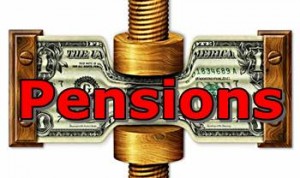Should New Mexico make a pension switch?

TIME FOR A CHANGE?: More states are converting to 401(k)-style pension plans. Should New Mexico lawmakers at least consider a change?
By Rob Nikolewski │ New Mexico Watchdog
SANTA FE, N.M. — Three weeks ago, Oklahoma became one of a growing number of states switching from traditional retirement systems for new state employees to plans that resemble 401(k)s.
The New Mexico Legislature so far hasn’t moved to follow the trend.
“I wouldn’t support it,” state Rep. Jim Trujillo, D-Santa Fe, and chairman of the Investment and Pension Oversight Committee, said Tuesday. “Our plan is doing well … A 401(k) would work, but the risk would be there, greater than what we have in our pension system.”
But Rep. Alonzo Baldonado, R-Los Lunas, is open to the idea.
“I think at least we need to look at it,” Baldonado told New Mexico Watchdog. “Not only as a state but as a nation, for years, we had these really nice pension plans, but the truth is … with improved medical technology, we have people living well into their 70s and 80s … You don’t want to end up where everyone’s bankrupt and nobody gets anything.”
Signed by Republican Gov. Mary Fallin on May 30, the new Oklahoma pension plan will see new state employees go from what is called a defined-benefit plan — in essence, a pension plan in which employees receive a fixed amount of money each month — to a defined-contribution plan, such as Oklahoma’s. Under that plan, workers will contribute a minimum of 3 percent to their retirement, and the state will match contributions up to 7 percent.
The bill signed by Fallin makes exceptions for teachers and “hazardous duty” employees such as cops and firefighters.
The law goes into effect next year and will affect all newly elected officials.
“Oklahoma pension systems currently have $11 billion in unfunded liabilities,” Fallin said upon signing the law. “The system as it stands today is not financially sound or sustainable. Moving future hires to a 401(k)-style system helps to ensure we can pay our current retirees and employees the benefits they have already earned.”
As state pension plans became more generous in recent years and a higher percentage of state employees reached retirement age, states have struggled to meet their increasing financial burdens. One estimate reports the U.S. has racked up $4.1 trillion in unfunded liabilities in public pensions.
As a result, more states are switching to 401(k)-style plans to save money.
All told, Oklahoma joined 19 states that have made the switch or at least offer options or hybrid systems for state employees.
Here’s an interactive graphic from the Illinois Policy Center, a free-market think tank in favor of 401(k)-style plans:
To do something similar in New Mexico, the Legislature would have to get the ball rolling.
“Around here, you’re going to get a little more pushback,” said Rep. Tim Lewis, R-Albuquerque.
In 2013, Gov. Susana Martinez signed a bill aimed at shoring up an estimated $12 billion hole in the state’s two giant state employee funds — the Public Employees Retirement Association and the Educational Retirement Board. Some critics say the fixes didn’t go far enough. PERA and ERB officials say the plans are back on solid financial ground.
“I think we should wait and see for at least the next three or four years and see how (the 2013 pension fix) works out,” Trujillo said.
Baldonado said it would be prudent to at least discuss making changes.
“If you worked all these years and then the system you paid into is not able to pay back, then you’ve got a bigger mess on your hands,” Baldonado said. “Look at the city of Detroit. That’s a disaster.”
Detroit is trying to climb out of a $18.5 billion bankruptcy filing, driven primarily by unsustainable retirement-benefit liabilities and mounting general-obligation debt.
Contact Rob Nikolewski at rnikolewski@watchdog.org and follow him on Twitter @robnikolewski







